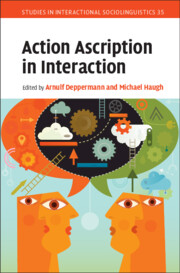Book contents
- Action Ascription in Interaction
- Studies in Interactional Sociolinguistics
- Action Ascription in Interaction
- Copyright page
- Contents
- Figures
- Tables
- Contributors
- Introduction
- Part I Constituents of Action Ascription
- Part II Practices of Action Ascription
- Part III Revisiting Action Ascription
- 12 Action and Accountability in Interaction
- 13 The Multiple Accountabilities of Action
- Book part
- Index
- References
12 - Action and Accountability in Interaction
from Part III - Revisiting Action Ascription
Published online by Cambridge University Press: 17 February 2022
- Action Ascription in Interaction
- Studies in Interactional Sociolinguistics
- Action Ascription in Interaction
- Copyright page
- Contents
- Figures
- Tables
- Contributors
- Introduction
- Part I Constituents of Action Ascription
- Part II Practices of Action Ascription
- Part III Revisiting Action Ascription
- 12 Action and Accountability in Interaction
- 13 The Multiple Accountabilities of Action
- Book part
- Index
- References
Summary
What is the relation between words and action? How does a person decide, based on what someone is saying, what an appropriate response would be? We argue: (1) Every move combines independent semiotic features, to be interpreted under an assumption that social behaviour is goal-directed; (2) Responding to actions is not equivalent to describing them; (3) Describing actions invokes rights and duties for which people are explicitly accountable. We conclude that interaction does not involve a binning procedure in which the stream of conduct is sorted into discrete action types. Our argument is grounded in data from recordings of talk-in-interaction.
- Type
- Chapter
- Information
- Action Ascription in Interaction , pp. 279 - 296Publisher: Cambridge University PressPrint publication year: 2022
References
- 3
- Cited by

